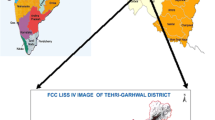Abstract
Agroforestry is a land use where trees are deliberately grown with agricultural crops either within the field or on the bunds/ boundary. There are innumerable examples of this traditional land use practices in many parts of the world and has long tradition in India too. In the state of Punjab, farmers prefer to grow tree species like Eucalyptus and Populus on their fields with agricultural crops. Reason for adopting these species by the farmers is their fast growth and use of wood in paper and plywood industries. These agroforestry systems are not only remunerative to the farmers but also improve soil fertility of agricultural fields. Area under agroforestry in Bathinda and Patiala districts has been assessed by applying pixel and sub-pixel classifiers on medium resolution LISS III data. In case of pixel based classification, area under agroforestry was estimated to be 7.09 and 4.95 % in the two districts, respectively. Whereas, area under agroforestry come out to be 14.76 and 13.25 %, respectively in case of sub-pixel based classification. Improved results were obtained in case of sub-pixel classifier with more than 85 % accuracy. Hence, sub-pixel classifier may be used with medium resolutions data for accurate assessment of area under agroforestry.







Similar content being viewed by others
References
Bentrup, G., & Leininger, T. (2002). Agroforestry: mapping the way with GIS. Journal of Soil Water Conservation, 57, 148A–153A.
Bernard, G., & Depommier, D. (1997). The systematic approach and the role of GIS in the characterization and monitoring of agroforestry parks. XI World Forestry Congress, Antalya, Turkey, 13 to 22 October 1997. 1:87p.
Bisen, P. & Patel, N.R. (2012). Feasibility of using high resolution and hyper-spectral satellite data for biophysical characterization of agroforestry systems. National Symposium on “Space Technology for Food & Environmental Security”. ISRS, N. Delhi, Dec. 5–7. 173p.
Bydekerke, L., Van Ranst, E., Vanmechelen, L., & Groenemans, R. (1998). Land suitability assessment for cherimoya in southern Ecuador using expert knowledge and GIS. Agriculture Ecosystem & Environment, 69, 89–98.
Campbell, J. B. (1996). Introduction to Remote Sensing (2nd ed.). New York: The Guilford Press.
DeFries, R. S., Townshand, J. R. G., & Hansen, M. C. (1999). Continuous fields of vegetation characteristics at the global scale at 1 km resolution. Journal of Geophysics Research, 104, 16911–16925.
FSI (2011). State of Forest Report, Forest Survey of India (Ministry of Environment & Forests), Dehradun. pp. 171.
Nair, P. K. R., Kumar, B. M., & Nair, V. D. (2009). Agroforestry as a strategy for carbon sequestration. Journal of Plant Nutrition & Soil Science, 172, 10–23.
Oki, K., Ojuma, H., & Sugita, M. (2002). Sub pixel classification of Aldar trees using multispectral Landsat Thematic Mapper Imagery. Photogrammetric Engineering & Remote Sensing, 68(1), 77–82.
Palaniswami, C., Upadhyay, A. K., & Maheshwarappa, H. P. (2006). Spectral mixture analysis for sub-pixel classification of Coconut. Current Science, 91(12), 1706–1711.
Pathak, P. S., Pateria, H. M., & Solanki, K. R. (2000). Agroforestry Systems in India: A diagnosis & Design Approach. New Delhi: NRCAF (ICAR).
Rizvi, R.H., Dhyani, S.K., Chaturvedi, O.P., Khan, I.A., and Keshav Datt. (2009a). Applications of GIS and Remote Sensing Technologies in Agroforestry: An Indian Perspective. Book of Abstracts, Agroforestry- The future of Global Land Use; 2nd World Congress of Agroforestry, World Agroforestry Centre, Nairobi: Aug. 21–23, 2009. pp. 256.
Rizvi, R.H., Yadav, R.S., Singh, R., Keshav Datt, Khan, I.A. and Dhyani, S.K. (2009b). Spectral Analysis of Remote Sensing Image for Assessment of Agroforestry Areas in Yamunanagar district of Haryana. National Symposium on “Advances in Geo-spatial Technologies with Special Emphasis on Sustainable Rainfed Agriculture”, RRSSC, Nagpur, Sept. 17–19, 7p.
Rizvi, R. H., Dhyani, S. K., Newaj, R., Saxena, A., & Karmakar, P. S. (2013). Mapping extent of agroforestry area through remote sensing: issues, estimates and methodology. Indian J. Agrofor, 15(2), 26–30.
Unruh, J. D., & Lefebvre, P. A. (1995). A spatial database for estimating areas for agroforestry in Sub-Saharan Africa: aggregation and use of agroforestry case studies. Agroforestry Systems, 32, 81–96.
Author information
Authors and Affiliations
Corresponding author
About this article
Cite this article
Rizvi, R.H., Newaj, R., Karmakar, P.S. et al. Remote Sensing Analysis of Agroforestry in Bathinda and Patiala Districts of Punjab using Sub-pixel Method and Medium Resolution Data. J Indian Soc Remote Sens 44, 657–664 (2016). https://doi.org/10.1007/s12524-015-0463-3
Received:
Accepted:
Published:
Issue Date:
DOI: https://doi.org/10.1007/s12524-015-0463-3




